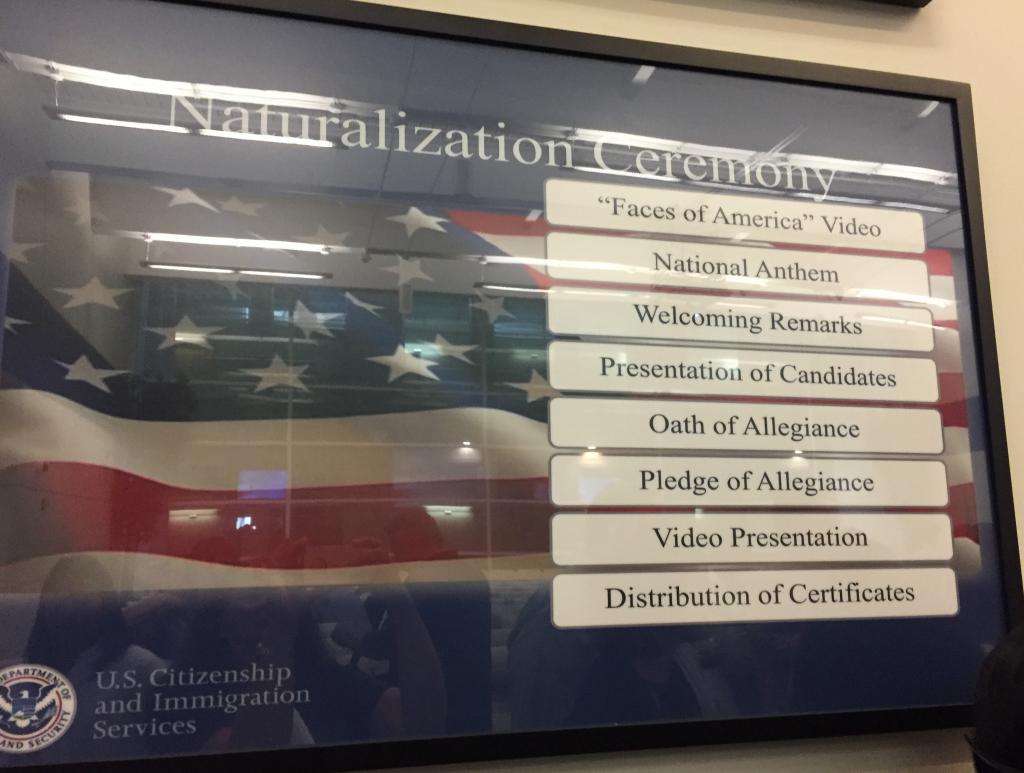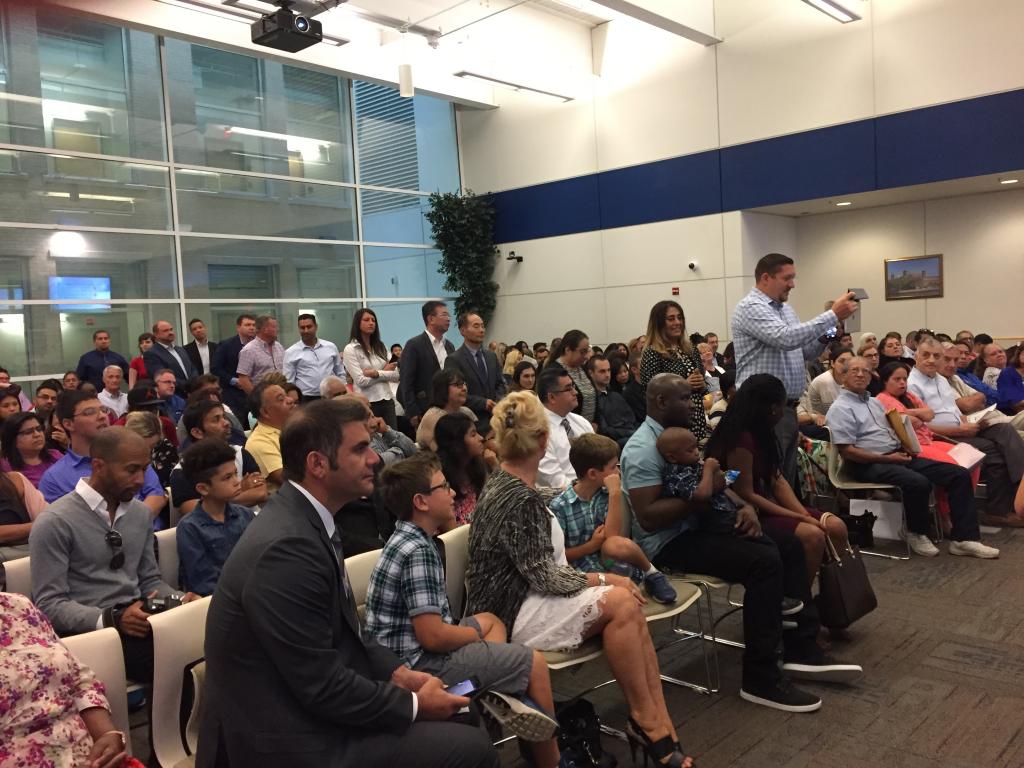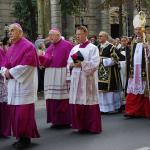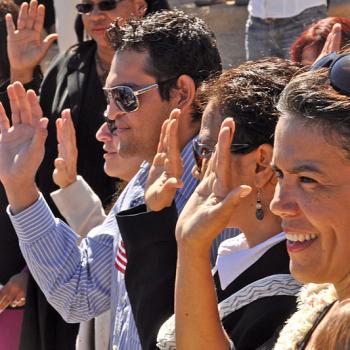Longtime readers will know that my husband grew up in Germany; he came here for grad school, we met, and he stayed, not so much because America is the Land of Milk and Honey as that it was clearly far easier for him to integrate into the U.S. (in terms of job opportunities, language, etc.) than the reverse. For many years, though, he had chosen to stay with the Green Card because the German government required that anyone naturalizing elsewhere, give up their German citizenship, and he didn’t want to lose the ability to travel freely or even return to Germany for a longer stay; several years ago, the German government established a process of retaining citizenship if you could demonstrate a good reason for having both citizenships, so he worked through this process, then started the naturalization process, and a little under a year later, took his oath of citizenship yesterday.
So let me tell you about the ceremony.
We arrived at the scheduled start time and were directed to a room that served as a waiting room for the ceremony as well as for naturalization interviews. The future new citizens were directed to one section of chairs, family and friends to a second section, and then, row by row, they directed the future new citizens to the auditorium, where, one by one, they showed their documents, turned in their Green Cards, and were seated in the same order. After this was complete (it took an hour or more) they called family and friends in, who sat in a separate section. Then the director of the ceremony gave some opening remarks, and the ceremony started.
Here’s the agenda, framed and hanging as you enter the room:

The “Faces of America” video was, in fact, a video of new immigrants, from Ellis Island onward. The National Anthem was a recording with lyrics on the video screen to which the audience was (to put the best face on it) too self-conscious to sing along to. Then we had a few congratulatory remarks, and the presentation of candidates, in which she called out names of countries of origin and asked everyone to stand and remain standing —
which was very interesting because, much as the Mexican friends and family were the only ones to cheer (like the, er, nonconformists at a school graduation), there were actually surprisingly few Mexicans. There were more Poles, and Eastern Europe, in general, was quite well represented, along with the Middle East and Asia, and the odd duck Canadian and Brit. Given that Mexicans make up, as of 2014 (the most recent data I could easily find) 15% of all newly naturalized citizens, and no Eastern European country has more than 1%, this seems odd, but may just indicate that Chicago simply does have a disproportionate number of these immigrants, and the Mexican/Hispanic immigration is relatively newer (or less legal) in Chicago. Apparently, too, Mexicans are much less likely than other immigrant groups to naturalize.
So anyway, we then had the Oath of Allegiance. And as a minor tidbit, there were three rows’ worth (maybe a dozen) of people there with interpreters. Some were older, though I was really surprised that others they met the criteria for eligibility for an interpreter (age 50 with 20 years of residence or age 55 with 15 years of residence); maybe I’m just not good at judging ages. In any event, the director told them, “interpreters, you have a job to do. They have to say the oath; I want to see mouths moving.”
Next up was the pledge of allegiance, and then the Video Presentation, which consisted of two parts: a “welcome video” by the president, and God Bless The USA with a naturalization-themed video.
Here’s the welcome video (from youtube):
Yes, it’s very Trump.
And, finally, the presentation of the diplomas — OK, the naturalization certificates. It did have pretty much the format of a graduation ceremony, though, with each person having the opportunity to have a picture with the director, with a family member or friend, or with the person in front or behind them in line taking the picture.
Here’s the scene:

It was not an enormous crowd, though they run these ceremonies, I heard her say, three times a day. There also seemed to be roughly even numbers of new citizens and family/friends, and some of the new citizens didn’t have anyone there to take a photograph.
So having said all that, was it what I expected? The image one gets is of something more celebratory, with people waving flags, hugs, and so on. But, much the same as you’re just a bit tired after waiting for everyone to get their certificate, we were just pretty much ready to go, and I had the feeling that was true of others, too, though there were many who stayed to take more pictures.
In fact, Richard Reeves proposed in a recent Washington Post piece that every high school student be required to attend a naturalization ceremony, in order to reduce prejudice against immigrants. The article is accompanied by a photograph of smiling new citizens waving mini-flags, identified as taking place at a Los Angeles ceremony. He writes:
These ceremonies are deeply, colorfully and unapologetically patriotic. Most participants and observers cannot help but be moved by the sight of people from around the world — despite an increasingly long and arduous application process to become a citizen — pledging their allegiance to the flag, singing the national anthem and, often tearfully, receiving their naturalization certificate.
And maybe all of this occurs under certain circumstances. Maybe different locations have more resources to direct into the production values, if you will. Maybe ceremonies on weekends or holidays are better-attended by family and friends. Maybe, even, there was tearful weeping all around me that I just didn’t see. But at the same time, of the new immigrants, how many were filled with joy and the long-hoped for prospect of citizenship, and how many regarded it purely as a practical step to take, as most of us would do in similar situations, to gain the tangible benefits of citizenship, from eligibility for benefits to protection from deportation and the ability to sponsor others for entry.
Readers, have you been to a ceremony?













